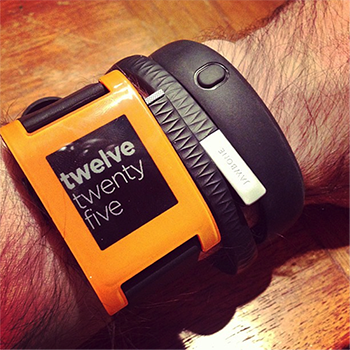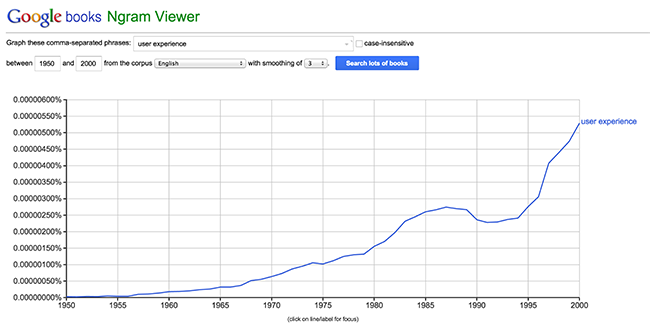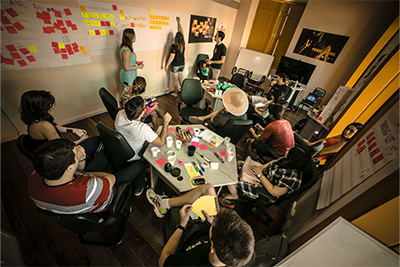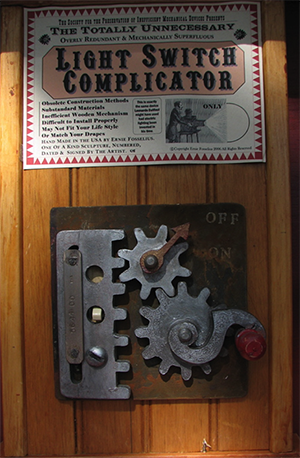
Data Lust and the IoT
By
Published: February 12, 2015
The Next Big Thing
You have likely heard by now of the Internet of Things (IoT), and perhaps, too, of the Quantified Self (or QS, for the hip). They’ll be all the rage soon, and are premised on the increasing prevalence of tiny, low-cost sensors, and the fast, cheap connections between them, that can go into our homes, our clothes, our cars, our watches, and potentially, even ourselves.
Think of Nest, the startup that Google snapped up last February, bringing “smart” data analytics to your home automatically, and one hopes, intelligently, regulate your thermostat. You could look too, at Wally, a startup using low-energy sensors to continually monitor your home for water leaks and mold - sending continuous updates to a slick phone dashboard, of course. There are more, and there will be more. Phillips recently released its Hue smart lighting, Cocoon promises to bring a tech approach to the problem of home security, and Sen.se has developed Mother, a set of sensors that can be placed on just about anything around your house and flexibly serve any number of functions (like monitoring your teeth brushing habits).

Photo Credit: Flickr user aaronpk, CC BY 2.0
Quantified Self and wearable applications are likely even more familiar, including the whole cadre of fitness tracking wristbands - Fitbit, Jawbone, Basis, the Angel Sensor, to name a few. And of course, the Apple Watch and HealthKit promise bold steps toward introducing the Quantified Self to the masses, to every Apple adherent in the world - a whole population of Quantified Selves.We live in an era of data lust. Today, the word alone, “data” - Big Data and data science are just two examples - evokes a heady aura of knowledge and wealth. The Temple of Apollo urged its admirers to “Know Thyself,” and today, this surfeit of data promises us, we really can. Data will tell us how to be smarter, fitter, and more efficient. It will improve our companies and our work at those companies, and when we’re done using data to improve our productivity, we can use it to improve our spirituality, too.
It’s no wonder that consumers are scrambling to adopt these technologies. As sensor-laden products grow smarter, smaller, less expensive, and more wearable (or ingestible), we’ll see massive adoption of these products - and we already are. The market outlook for wearable sensor technology is extremely rosy, and all indicators point toward the Internet of Things growing incredibly quickly over the next decade. Individuals see the same promise of efficiency and fitness coming out of “Big Data” as every forward-thinking company out there. Personal sensors can help me effortlessly lose ten pounds, you say? I’ll take two.
But the sensors, the technology, the data - they aren’t everything. Without context, without understanding the end users and use contexts, the technology will fail to face real, sustained adoption and utilization. Worse yet, it might cause harm - if the Internet of Things is a roaring machine, paving our way through the next decade, then personal data - our personal health and home and family data - will be its fuel. As we move forward into the world of smart pills and watches and toasters, we’ll have to vigilantly attend to the context in which they’re being deployed. In the Internet of Things, context will be everything. Context will be king.
Big Data, Big Unintended Consequences
So the Internet of Things is coming - what’s an organization to do about it?Much has been said, and rightly so - including here at Thoughtworks - about the increasing need to manage the data that these emerging technologies will create. High quantity data collection, throughput, analysis, storage, security, and more - these are, and will continue to be, topics of incredible relevance to the success or failure of the IoT and QS.
Another area that’s gotten less attention, but is increasingly important to consider, is the understanding of the contexts into which these technologies will be deployed. The appreciation of User Experience (UX) design and research has been on the rise in recent years, and it will only continue to grow as these technologies become more prevalent in our lives. A thorough understanding of deployment context and user psychology is often the missing link in the development of these emerging technologies. Emerging tech is great - it’s fun and innovative and just about oozes business potential - but it’s nearly worthless without people to adopt, and then continue to use, that technology.

Appreciation of User Experience has been on the rise, and will continue to grow.
IoT and QS technologies will almost surely provide a great deal of benefit for learning about users. While technology today allows for a short feedback loop between designers, developers, researchers, and end users, tomorrow’s tech - the kind we can’t see, the networked kind in our watches and cars and refrigerators - will make this feedback loop even smaller, more responsive. User research in the era of the IoT may look quite different from what it is today - many of the methods may be the same, but the ability to gain feedback quickly and more accurately will improve greatly.
These issues, centering around the possibilities of these coming technologies for gaining insight into user context and experience, are manifold, and surely important to discuss - and surely will be discussed, by me and others, over the next several months and years. But these same technologies will require a great deal of context as well, else will face rejection at best, and radical upheaval at worst. It is this context - the need for it, the need for user research and contextual understanding that must be achieved before even beginning to deploy these technologies, that will be our focus here.
Understanding the Context
While contextual research consists of a number of methodologies - ethnography, interviews, surveys, and more - the unifying theme of these, the ultimate goal of the research, is a kind of context-getting. Above all, these methods seek to understand the context in which the technology will be used - what language do the users speak and read (and do they read?); how do they use their cars, homes, phones, and watches; what are the norms of their culture around data privacy, sharing, notifications, and more; and, once the technology is in use, how will it be used or misused? What are the pain points, pleasantries, and annoyances of the technology? What are the unintended consequences that emerge out of its use?
And what about your friends’ experiences of those same apps - they will, generally speaking, be the same apps - they will evoke similar emotions in their users, and react similarly to similar inputs.
Now consider IoT and QS. They’re highly personal, and moreover, highly pervasive. Many people use their cars for several hours a day, and the vast majority of us spend many hours a day - sleeping, if nothing else - in our homes. Fitness trackers are designed to be worn at all times - even while sleeping and in the shower - and as sensors become smaller and cheaper, the ubiquity of technology in every aspect of our lives will only continue to increase. These emerging technologies will be incredibly context-dependent, and we will be around them all the time. They may have to take into account the sensitivity of my own unique health data, the design of my house, the type of car I’m used to driving, maybe even the likelihood of my skin developing a reactionary rash.
In short, in the burgeoning future of wearable technology and the IoT, context will matter. A lot.
These technologies are not only more pervasive, they’re more invasive too - sensors will know when users are home (or not), when they’re asleep (or not), and how their heart rate, energy, exercise levels, food, caffeine, and alcohol consumption compare with the same yesterday, or last week, or last year. (And oh yes - how they compare with those of their spouse, neighbors, and coworkers, too.) If she plans to use an Apple Watch, she should also be prepared for the possibility that her personal health data - her medications, allergies, and other special medical needs - might be hacked, or more easily just given up, should she ever leave the watch somewhere and forget to lock it.
Because these technologies will be around us so much more often, and have so much access to our data, they will also present many more unforeseen consequences. UX research, and the contextual understanding that comes with it, can help to discover these unforeseen consequences before they become large problems.
The emerging IoT and QS technologies look great when they’re improving our health and homes, but they’re a lot less appealing when a bug or malicious hack leads to stolen health data, a failure to catch water leaks or broken pipes, missed fire alarms, or home break-ins. Our smart cities, cars, roads, homes, and watches are all about context, and the stakes are much higher. If you misuse an app today, then you might get frustrated; you may even stop using it. But if you misuse the app on your watch holding all your private medication data? If you misuse your car? If you misuse your fire alarm?
Even without misuse, recommender systems have famously made erroneous inferences about users. Recently, Sarah M. Watson wrote, “My stupid refrigerator thinks I’m pregnant. I reached for my favorite IPA, but the refrigerator wouldn’t let me take one from the biometrically authenticated alcohol bin.… Our Fountain™ tracking toilet noticed when I got off hormonal birth control and got an IUD instead. But I thought our toilet data was only shared between Nest and our doctors? What tipped off our Samsung fridge?”
The story is fiction, but it’s eerily believable.
Even when the new technology doesn’t create any imminent danger, or think you’re pregnant, it can still create unexpected hassles where none previously existed. (Or maybe just creep you out.) See, for example, Phillips’ need to create a special Hue Tap app to control their new smart lightbulbs. “Now control your hue lights in your home with just the push of a button”. Funny - I thought that’s what I’d been doing all along.

The specific subset of consumer health technology - fitness trackers, innovative communications methods between patients and physicians, and the Apple Watch among them - presents a specific set of adoption challenges and data protection over and above those present anywhere else. Some individuals are already pushing back on the idea of technology coming even closer to (or under) our skin, while others in our society have spoken loudly about the need to be careful to protect our protected health information. Moreover, many in the health profession itself are skeptical that wearables will bring any immediate improvement to our ill health system, at least in the near future.
“Thousands of heart rate measurements, hundreds of blood pressure readings and daily fitness data are more likely to overwhelm doctors than inform them. Few physicians see value in receiving gigabytes of unsolicited information and data,” writes Robert Pearl, a physician, in Forbes.
If we can’t get medical professionals on board with our health technology, then it’s hard to see how these technologies will begin to provide any lasting benefit.
Driving Forward
Don Norman, perhaps the godfather of human factors research and design, and a great promoter of contextual understanding in tech development, classically crafted a fictional, newspaper article describing a not-all-that-unrealistic scenario involving a self-driving car. “Motorist trapped in traffic circle 14 hours,” the headline cries.“Newone, 53, was driving his newly purchased luxury car when he entered the traffic circle in the city center around 9 AM yesterday, Friday. The car was equipped with the latest safety features, including a new feature called Lane Keeping. “It just wouldn’t let me get out of the circle,” Newone said. “I was in the inner-most lane, and every time I tried to get out, the steering wheel refused to budge and a voice kept saying over and over, ‘warning, right lane is occupied.’ I was there until 11 at night, when it finally let me out,” Newone said from his hospital bed, his voice still shaky.”
Norman wrote this scenario years ago - on April 1, it’s worth noting, of 2006 - and it was pure fiction then. But as we move into the brave new world of smart cities, smart homes, smart watches, and whatever other “smart” thing finds their way onto (or into) our bodies, this scenario, and the dangers emerging from it, will become all the more important to foresee and prevent.
This drive into the future, the growth of the Quantified Self and the IoT, isn’t slowing down. The technology is getting cheaper, smaller, and smarter, and as more individuals heed the lusty drawl of Big Data, hear its seductive promises of slimmer bodies, bigger brains, and unseen, yet-unknown efficiencies, they will flock, as surely as they’ve flocked to new technologies before. But this flocking, this lust, will not excuse irresponsibility. There have already been mistakes in the way these technologies are deployed, and there has already been backlash. To avoid its increase, we must be careful and contextually-aware in our design and development.
Almost certainly, as technology begins to pervade our lives and worlds more fully than it already does, individuals will rebel; anti-technology movements will grow. Indeed, they already have. There will be tremendous, important discussions about pervasive technology and implanted sensors, about all the data leaks and the peoples’ lives that have surely been hurt because of them.
But if we’re careful, if we’re really careful, these things won’t happen for a few years - and maybe not at all. They don’t have to happen.
If we’re able to heed user context, and design these technologies responsibly, then the Internet of Things will continue to expand rapidly, user interest will expand with it, and those who invest in this technology, who yearn for this data and all its promised manna - the trinity of knowledge, wealth, and efficiency - will surely reap it.
Disclaimer: The statements and opinions expressed in this article are those of the author(s) and do not necessarily reflect the positions of Thoughtworks.














